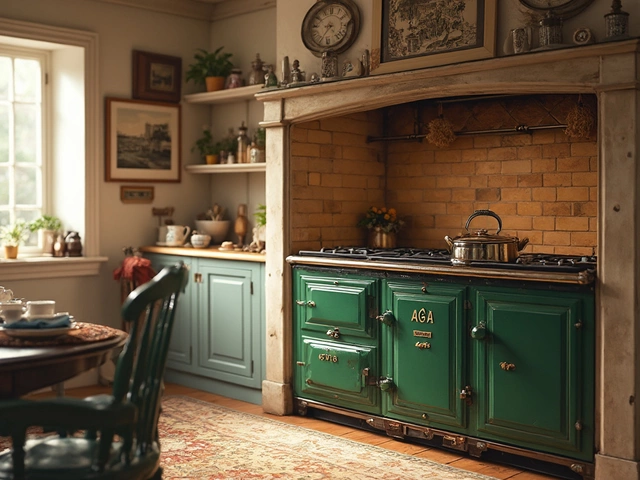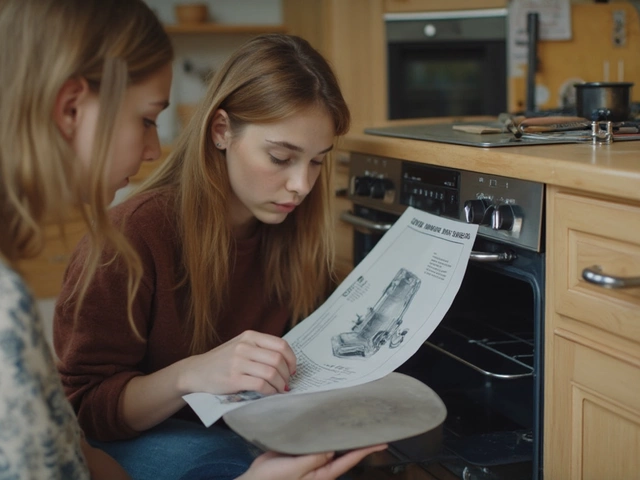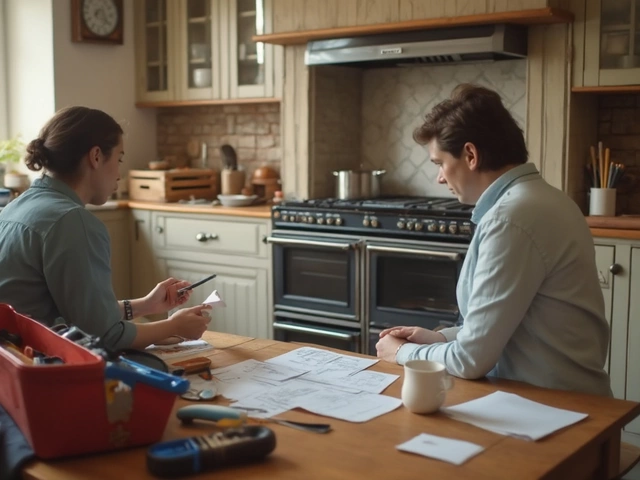So your electric oven is on its last legs or just gave up completely. Wondering if you can swap it out with your own two hands? You’re definitely not alone—lots of folks try to dodge the cost of a pro by going the DIY route. Before you pull that oven out and start hunting for your toolbox, there’s a lot more to it than just unplugging one and sliding in another.
If you’ve ever replaced a toaster, don’t expect the same kind of job. An electric oven connects straight to your home’s electrical system. Miss one step, and you’re looking at tripped breakers, sparks, or worse. But hey, with the right approach and a bit of confidence (plus a heavy dash of caution), some folks do it themselves—usually after watching a bunch of YouTube videos and reading forums until their eyes hurt.
You’ll need to figure out what’s hiding behind your cabinets. Is your new oven the same size as your old one? Are the wires easy to reach? Does your home’s electrical panel even support it? Missing answers to these questions can turn a simple Saturday project into a week-long hassle. The goal here: give you a clear sense of what you’re up against before you decide to tackle it solo or make the call for help.
- Sizing Up the Job: How Hard Is It?
- Safety First: Power, Wires, and Other Hazards
- Step-by-Step: What Replacing an Oven Really Involves
- Common Mistakes People Make
- When to Call in the Pros
Sizing Up the Job: How Hard Is It?
Swapping out an electric oven isn’t as simple as changing a microwave. The main thing folks underestimate? The weight and awkward shape of most ovens. Even compact units tip the scale at 100 pounds, and some double-wall models can weigh almost twice that. Unless you enjoy wrestling metal boxes in tight spaces, you’ll want a second set of hands when moving the appliance.
It’s more than just muscle, though. What truly trips people up is matching the new oven to the old cutout. Ovens come in a mess of standard widths—24, 27, or 30 inches—and the depth and height aren’t always what you expect. If your cabinet or counter opening is even a half inch off, you’ll either face tough modifications or an oven that just refuses to fit.
- Measure your old oven and the cabinet cutout before you hit “buy” on a new unit. Scroll through your oven’s manual (or search for it online if you tossed it years ago) for the exact fit.
- Check that your home’s wiring and outlet match the new oven. Most built-in electric ovens need a dedicated 240-volt circuit. If you’re not sure, pop the breaker panel open and check for a double-pole breaker, usually labeled “Oven” or “Range.”
- Think about your floor and wall protection. Sliding out an old oven can leave you with scratched tile or beat-up drywall if you’re not careful.
For a quick look at what makes some jobs way harder than others, here’s a table of typical oven features and what they add to the replacement hassle:
| Feature | Extra Difficulty Factor |
|---|---|
| Wall oven (vs. slide-in) | Higher—must lift and align in cabinet cutout |
| Double oven | Much heavier and bulkier |
| Old wiring (pre-1980s) | May need upgrade, more work |
| Irregular cabinet/counter shapes | Custom carpentry or adjustments needed |
If your current oven is hardwired instead of plugged in, the job goes from basic DIY to intermediate real quick—the wiring isn’t impossible, but it takes careful work and safety measures. So, before you even consider disconnecting anything, figure out your model, the install style, and whether or not you own basic tools. The real difficulty? It all boils down to matching oven with opening and making sure your home’s wiring is up to the job. Not sure about either? Slow down and double-check before moving anything around.
Safety First: Power, Wires, and Other Hazards
Messing with an electric oven isn’t like changing out your fridge or plugging in a coffee maker. You’re dealing with a machine that usually runs on 240 volts—double what your regular outlets send out. That kind of power can seriously hurt you, so safety comes before everything else here.
First, never work on your oven while it’s still getting power. Don’t just turn the oven off—head straight to your breaker box and shut off the circuit powering the kitchen appliances. Test to make sure it’s off by using a voltage tester or meter. No guessing. Double-checking can save your life.
Oven wires aren’t just twist-and-tape stuff. You’ll usually find three or four heavy wires (black, red, white, and sometimes bare/copper ground). Wrong connections or loose wires can lead to blown fuses, breaker trips, or worse—kitchen fires. If your wiring doesn’t match, stop right there. Sometimes you’ll need a new outlet, or your panel just isn’t up to code for modern ovens.
If your oven is built-in, watch for hidden wires or unusual placements behind the unit. It’s not uncommon to see tight spaces or wiring that won't budge. For apartments or older homes, you might even find outdated setups, like aluminum wiring—which comes with its own set of risks.
Tools matter, too. Insulated screwdrivers, wire strippers, and a proper voltage tester aren’t optional—they’re baseline. Don’t try to get by with whatever’s in the junk drawer. Protective gloves are also smart, even if you feel confident around electricity.
One more thing: believe it or not, about 30,000 electrical fires start in U.S. homes every year, and kitchen appliances are a top culprit. That stat isn’t there to scare you—it’s just a reminder that there’s no prize for rushing or skipping steps when dealing with electricity.
- Turn off power at the breaker, not just at the oven
- Use a voltage tester every single time
- Understand your home’s wiring—don’t just wing it
- Don’t be shy about calling a pro if you have any doubts
- Keep a fire extinguisher nearby, just in case
Bottom line? If you’re not totally sure what you’re doing, it’s way smarter and safer to call in an electrician. Your oven (and kitchen) will thank you for it.

Step-by-Step: What Replacing an Oven Really Involves
Tackling an electric oven swap isn’t as easy as unplugging your microwave, but if you’re comfortable with basic tools and know how to stay safe, it can be done. Here’s how the process usually shapes up.
- Turn Off the Power. This is serious. You’ve got to shut off the circuit breaker connected to your oven. Never trust that just flipping a wall switch cuts the juice. Double-check using a voltage tester at the oven connection before doing anything else.
- Remove the Old Oven. Most electric ovens are either slid into a cabinet or stand alone. You’ll likely need to unscrew brackets or mounting hardware. Sometimes there’s a trim kit covering screws—just pop it off carefully. Ovens are heavy, so having an extra set of hands is a good idea.
- Disconnect the Wires. Once the oven’s out far enough, you’ll see a junction box where wires connect. Take a clear picture before you undo anything so you remember how it was wired. Usually, you’ll see black (hot), red (hot), white (neutral), and a bare copper or green (ground) wire.
- Double-Check Measurements. Before dragging the new oven into place, measure the opening. Even an inch off can mean it won’t fit, which is a pain you really don’t want. Modern ovens are often deeper or wider than older models.
- Connect the New Oven. Match the colored wires just like the photo you snapped earlier: black to black, red to red, white to white, and ground to ground. Tighten wire connectors solidly—loose wires can cause major issues.
- Slide the Oven into Place. Push it in slowly to avoid crushing the wires or pinching anything. Make sure it’s level so you don’t get crooked cookies or tipping pans.
- Screw Everything Back Together. Reattach any brackets, hardware, or trim kits. You want that oven snug so it doesn’t wobble or tip forward when you open the door.
- Turn the Power Back On and Test. Flip the breaker back and check if the oven powers up. Run it through a short bake cycle and make sure nothing smells smoky or seems off. If it trips the breaker, stop right away—something’s not right.
Here’s a quick look at typical home oven electrical requirements, so you’re not left guessing:
| Requirement | Standard Value |
|---|---|
| Breaker Size | 30–50 amps |
| Voltage Needed | 240V |
| Dedicated Circuit? | Yes |
One thing you really want to avoid is stripping wires too short or leaving connections exposed. A small mistake here can cause fires or shock risks. If something feels sketchy or confusing at any point, don’t push through—there’s no shame in getting help. And don’t forget, dragging an oven across hardwood or tile can destroy your floors. Lay down a blanket or big piece of cardboard first. That’s one of those rookie mistakes that hurts the wallet.
Swapping out an electric oven might sound intimidating at first, but with patience and focus it’s definitely possible for a DIY-minded cook. Just treat every step like it matters—because it really does.
Common Mistakes People Make
Trying to replace an electric oven without really knowing what you’re doing? That’s when things go south fast. One classic mistake is not turning off the power at the main breaker. Just flipping the oven switch off isn’t enough—some ovens hold a charge or can zap you from a different circuit. Over 30% of home electrical accidents happen because people skip this step.
Another headache: folks mix up the wiring. Old ovens often use different colored wires or even odd setups from back in the day. Plugging wires in the wrong spots can fry your new oven or mess up your kitchen’s power. J.D. Power, a leading consumer advocate, says:
"Mistakes with wiring during oven installations are one of the top reasons for costly callbacks and fire risks in home kitchens."
Then there’s the problem of bad measurements. New ovens usually aren’t an exact fit to the old cutout, even if the product listing swears they’re both 30 inches wide. Forgetting to measure the depth, the cabinet trim, and space behind for wires is a recipe for extra holes or a crooked install. Here’s some common error areas and what happens if you miss them:
| Mistake | What Can Go Wrong |
|---|---|
| Skipping power shutdown | Electrical shock or blown fuses |
| Wrong wiring connections | Short circuits, fire risk, dead oven |
| Bad measurements | New oven won’t fit, gaps in cabinetry |
| Ignoring user manual | Voiding warranty, missing key steps |
Lifting the oven by yourself is another move you’ll regret. New ones can weigh up to 200 pounds, which is a bad surprise for your back and your floor. Even a little slip can scratch those kitchen tiles or dent your cabinet trim. And if you don’t make sure the oven is level before tightening those screws, good luck baking pizza without cheese slide-off.
One more thing—folks often forget there’s a warranty on that shiny new oven. If you mess up the install, the company can refuse to help you when something breaks later. So take a second and read the terms before trying to save a few bucks on labor.

When to Call in the Pros
Some jobs just aren’t worth the risk—replacing a electric oven can be one of them. If you start dealing with wires and notice anything that doesn’t match the manual, or if your breaker panel looks like spaghetti on a bad day, that’s your cue. A certified electrician isn’t just for worst-case scenarios—sometimes, it’s the cheaper, safer bet in the long run.
Here are a few solid reasons to pick up the phone instead of a screwdriver:
- Your home is older and has quirky wiring—sometimes old wires just don’t play nice with new ovens.
- You see burnt wires, broken outlets, or melted insulation. This is a major red flag for electrical fire risk.
- The oven connection doesn’t match the plug or wiring setup in your kitchen. Retro-fitting isn’t a job for trial and error.
- You don’t have a dedicated 220-volt circuit. Modern electric ovens almost always need this much juice, and forcing it onto a weaker line can lead to constant tripping (or dangerous overheating).
- You aren’t sure if you actually turned off the power at the correct breaker. Even pros check with a tester—guessing could land you in the ER.
If you hit any of these snags, hiring a pro isn’t just about convenience. Electricians are trained to spot problems the rest of us miss, and a lot of local building codes actually require a permit (and a licensed contractor) for major electrical jobs. Skip this step, and you could void your home insurance if there’s ever damage from a bad hookup.
If you’re still on the fence, here’s something that might help: a HomeAdvisor study from early 2024 showed the average cost for electric oven installation in the U.S. is between $120 and $275, including labor and basic materials. Compare that to the price of fixing mistakes—and it’s suddenly not such a steep price to pay.
| Scenario | DIY Safe? | Call a Pro? |
|---|---|---|
| Matching outlets, no visible damage | Yes | No |
| Unfamiliar wire colors, old circuit box | No | Yes |
| Evidence of burnt wires | No | Yes |
| Permits/code requirements | No | Yes |
So sure, it’s tempting to save a couple bucks, but sometimes it’s just not worth the headache—or the risk. If something feels sketchy or is just above your level, don’t sweat it. Let the pros handle what they’re trained for and enjoy your new oven without any drama.




